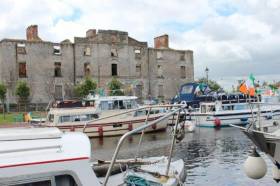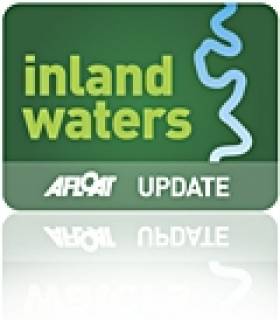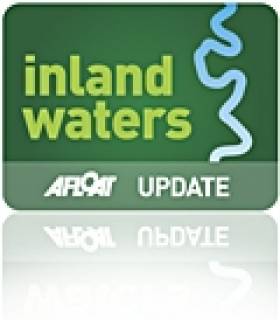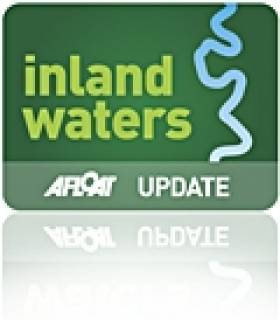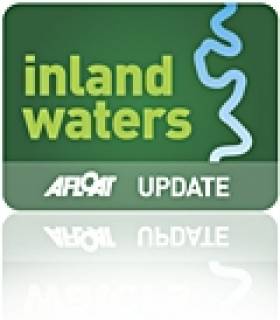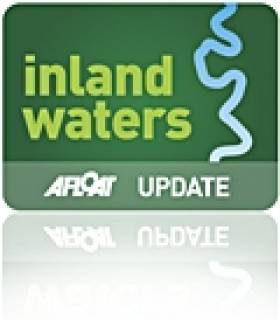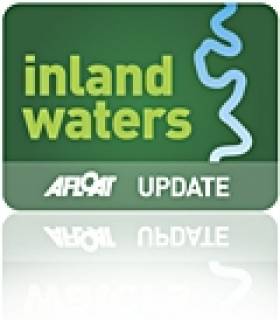Displaying items by tag: Shannon Harbour
Shannon Harbour Canal Boat Rally Is Back On The Agenda
#Heritage - The Shannon Harbour Canal Boat Rally will go ahead this month, despite reports of its recent cancellation.
Afloat.ie has learned that a new voluntary group has taken over the hosting of the rally, after Inland Waterways Association of Ireland (IWAI) Shannon Harbour branch chair Damien Buckley announced it would no longer be running.
Gerry Burke of the IWAI’s Lough Derg branch led the charge to maintain the tradition of the heritage event during the recent Jamestown Heritage Festival in Kildare.
It means 2018 will indeed mark the 47th edition of the Shannon Harbour Canal Boat Rally, which will take place over the weekend of Friday 15 to Sunday 17 June.
Sailing Vessel Sunk on Grand Canal at Shannon Harbour
#grandcanal – Waterways Ireland advises masters and owners that a small unidentified sailing vessel is sunk in Shannon Harbour approx. 500 metres East of Griffith Bridge on the south bank.
The vessel is an obstruction to navigation.
The mast is lying across the navigational channel, however, the vessel may be passed with due caution. It is planned to remove the vessel on Friday morning, 28th Feb 2014.
Shannon Missing Navigation Mark at Athlone
#InlandWaterways - Waterways Ireland advises masters and owners that a green starboardhand navigation mark is reported missing just south of Athlone Lock on the eastern side of the Shannon Navigation opposite the old Athlone Canal entrance.
Masters should proceed with caution when navigating this section of the river.
Elsewhere on the Shannon, a triathlon swimming training course is now set out in Lough Key between Castle Island and the mainland to the west, in an area off the navigable channel.
This will be in place until the end of September and is marked by four yellow buoys. When swimmers are on the course they will be accompanied by a safety boat and will be wearing high visibility swim hats.
Training will take place Mondays, Wednesdays and Fridays from 7am till 8am and Tuesday and Thursday from 6pm till 8pm. Masters are requested to navigate at slow speed and with a low wash when passing the area.
Further information may be had from Donal Kennedy of Lough Key Triathlon Club at 086 109 2626 or [email protected].
Meanwhile, a swimming event will take place on Sunday 9 June from Shannon Harbour to Banagher Harbour.
Masters are requested to navigate at slow speed and with a low wash when passing the area during the event, which will take place between 1pm and 3.30pm.
For more details contact Jerry O’Meara of Shannonside Sub Aqua Club at 087 776 4252 or [email protected].
Bidding Begins for Shannon Harbour Houseboat Berths
#SHANNON - Waterways Ireland has just released details of its scheme for renting berths for houseboats on the Grand Canal at Shannon Harbour.
Under the scheme, boaters can rent one of eight fully-serviced berths for their houseboat on a 12-month extended term licence running from 15 March 2012 to 14 March 2013.
Amenities on-site include electricity supply, access to pumps and clean water, shower facilities and limited car parking. Pre-paid smart cards are required to utilise some facilities.
As space is limited, the berths will go to the highest bidders, with the minimum acceptable bid set at €1,250 (a security deposit of €250 is required).
It is expected that licence holders will live on board their vessels as their main residence. Winning bidders are also expected to arrange their own refuse collection from the site.
The closing date for bids is 23 February 2012. The Waterways Ireland website has the application form plus more information about the scheme and details of the licence agreement.
Sailors Plan Month Long Journey from Shannon to Liffey and Back
Nenagh resident and inland waterways enthusiast, Nick Theato, single-handed aboard 'Bo-Bo, a five metre Pedro trailer/sailer and Pat Kelly, Killadangan, with his son Andrew in 'Shu-Ra-Nu', a 6 metre Etap 20 trailer/sailer, plan to raise funds for Lifeboats Ireland by undertaking the IWAI Green & Silver Challenge in June, 2011. Their fundraising target is €5,000.00.
On the 25th June, 1946, Tom and Angela Rolt left Athlone aboard 'Le Coq', a 28ft.x8ft. converted ship's lifeboat on a voyage that would inspire contemporary and successive generations of inland waterways enthusiasts.
Tom Rolt wonderfully documented the voyage in his book 'Green & Silver', published in 1949, which has since become a classic. This work was instrumental in inspiring the small group who founded the Inland Waterways Association of Ireland in 1954, whose objective was to save the Shannon navigation from strangulation by low bridges. Indeed, the colour scheme of the IWAI's logo and burgee derive from the cover design of Rolt's book.
With the re-opening of the Royal Canal in October 2010, it is now possible to retrace Rolt's journey in full and complete the circular route formed by the Royal Canal, River Liffey, Grand Canal, River Shannon and Camlin River.
To celebrate this event, the IWAI has initiated the 'Green & Silver Challenge' in an effort to encourage people to make the circular journey. Nenagh resident, Nick Theato single-handed aboard 'Bo-Bo, a 16 foot Pedro trailer/sailer and Pat Kelly, Killadangan, with his son Andrew aboard 'Shu-Ra-Nu', a 20 foot Etap trailer/sailer, plan to raise funds for Lifeboats Ireland by travelling the full Green & Silver Route throughout June 2011.
Departing on June 1st, they will travel from Dromineer through Lough Derg and Lough Ree and enter the Royal Canal at Richmond Harbour. They plan to cross the Liffey in Dublin 17 days later, where they will take a welcome day off before commencing the return journey via the Grand Canal to Shannon Harbour. The journey will take approximately 28 days, will cover a minimum of 333 km. and navigate through 92 locks (some double), 91 of which are manual. Their fundraising target is €5,000
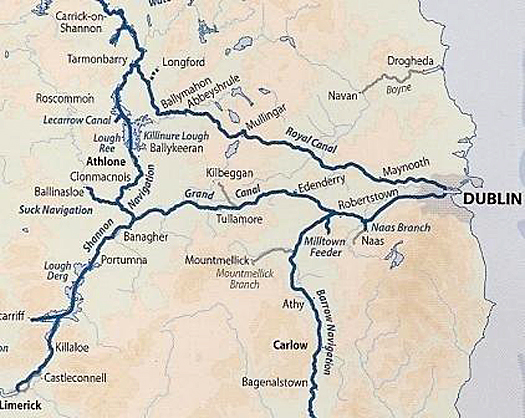
Nick Theato is Treasurer of the Lough Derg RNLI Fundraising Branch and Lough Derg Lifeboat Station at Dromineer.
Pat Kelly is Secretary of the Lough Derg RNLI Fundraising Branch.
Nick and Pat welcome all sponsorship, however modest. Contributions can be pledged online at http://www.mycharity.ie/event/green_silver_event/. Nick may be contacted on 086 1738014 ([email protected]). Pat is at 087 6908099 ([email protected]).
For further details / interviews / photos: Contact Pat Kelly at 087 6908099 ([email protected]). Support photography: Gerardine Wisdom 087 6522582 ([email protected]).
Navigable Channel in Shannon Harbour Now Open
Inland waterways Marine Notice No. 27 of 2011 Waterways Ireland advises masters and users that the navigable channel in Shannon Harbour on the Grand Canal is now open. The new house boat facility remains closed to the public as construction work continues.
Click this link for the latest boating news on Ireland's Inland Waterways
Marine Notice: Grand Canal Shannon Harbour
Owners are advised to monitor and tend mooring lines as levels may fluctuate at the time of re-filling.
Charles Lawn
Lt Cdr (rtd)
Inspector of Navigation
27 Jan 2011.
Tel: 00 353 (0)90 6494232
New Houseboat Facility Gets Green Light on the Shannon
Following receipt of planning permission, Inland Waterways Ireland is progressing with the development of a houseboat facility in Shannon Harbour where the Grand Canal meets the Shannon.
The result will be a serviced mooring facility in Shannon Harbour for 6-8 boats. This will include moorings, area lighting, electricity and water.
A section of the Grand Canal, from the 34th Lock to the 35th Lock inclusive, will be closed to navigation between 1st November 2010 and 14th March 2011 to facilitate the improvement works. The towpaths will also be closed during the period of the works.
The design and commissioning of the work has been undertaken by Waterways Ireland. The tenders are currently being assessed and will be awarded shortly.
Waterways Ireland has issued a notice to users of the Grand Canal of its intention to carry out new inland waterways works by way of provision of house boat berths at Shannon Harbour, Co.Offaly.
The work site will be from Griffith Bridge to a point approximately 200m eastwards of the bridge. A temporary dam will be constructed in the vicinity of this site which will close the canal to navigation at this location.
The work is expected to commence in Oct 2010 and be completed by Mar 2011. Any owners planning to transit the canal at this time should take into account this closure, say the Waterways body.


























